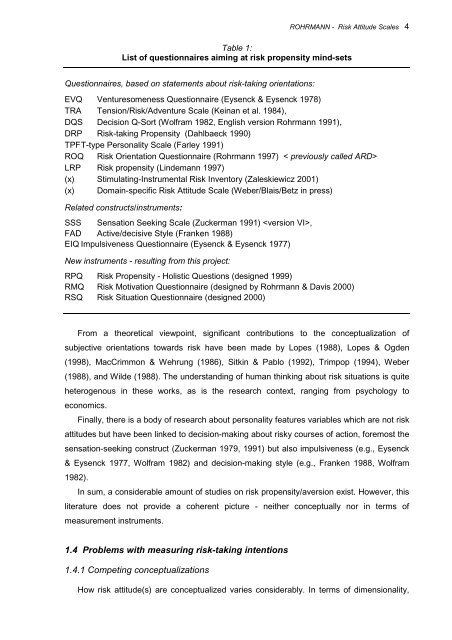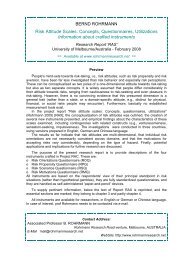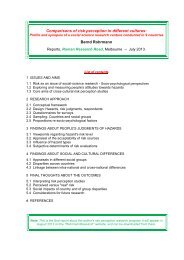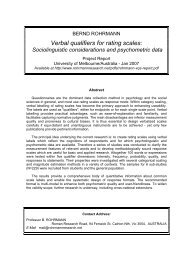Risk Attitude Scales: Concepts, Questionnaires, Utilizations
Risk Attitude Scales: Concepts, Questionnaires, Utilizations
Risk Attitude Scales: Concepts, Questionnaires, Utilizations
Create successful ePaper yourself
Turn your PDF publications into a flip-book with our unique Google optimized e-Paper software.
ROHRMANN - <strong>Risk</strong> <strong>Attitude</strong> <strong>Scales</strong> 4<br />
Table 1:<br />
List of questionnaires aiming at risk propensity mind-sets<br />
<strong>Questionnaires</strong>, based on statements about risk-taking orientations:<br />
EVQ Venturesomeness Questionnaire (Eysenck & Eysenck 1978)<br />
TRA Tension/<strong>Risk</strong>/Adventure Scale (Keinan et al. 1984),<br />
DQS Decision Q-Sort (Wolfram 1982, English version Rohrmann 1991),<br />
DRP <strong>Risk</strong>-taking Propensity (Dahlbaeck 1990)<br />
TPF T-type Personality Scale (Farley 1991)<br />
ROQ <strong>Risk</strong> Orientation Questionnaire (Rohrmann 1997) < previously called ARD><br />
LRP <strong>Risk</strong> propensity (Lindemann 1997)<br />
(x) Stimulating-Instrumental <strong>Risk</strong> Inventory (Zaleskiewicz 2001)<br />
(x) Domain-specific <strong>Risk</strong> <strong>Attitude</strong> Scale (Weber/Blais/Betz in press)<br />
Related constructs/instruments:<br />
SSS Sensation Seeking Scale (Zuckerman 1991) ,<br />
FAD Active/decisive Style (Franken 1988)<br />
EIQ Impulsiveness Questionnaire (Eysenck & Eysenck 1977)<br />
New instruments - resulting from this project:<br />
RPQ <strong>Risk</strong> Propensity - Holistic Questions (designed 1999)<br />
RMQ <strong>Risk</strong> Motivation Questionnaire (designed by Rohrmann & Davis 2000)<br />
RSQ <strong>Risk</strong> Situation Questionnaire (designed 2000)<br />
From a theoretical viewpoint, significant contributions to the conceptualization of<br />
subjective orientations towards risk have been made by Lopes (1988), Lopes & Ogden<br />
(1998), MacCrimmon & Wehrung (1986), Sitkin & Pablo (1992), Trimpop (1994), Weber<br />
(1988), and Wilde (1988). The understanding of human thinking about risk situations is quite<br />
heterogenous in these works, as is the research context, ranging from psychology to<br />
economics.<br />
Finally, there is a body of research about personality features variables which are not risk<br />
attitudes but have been linked to decision-making about risky courses of action, foremost the<br />
sensation-seeking construct (Zuckerman 1979, 1991) but also impulsiveness (e.g., Eysenck<br />
& Eysenck 1977, Wolfram 1982) and decision-making style (e.g., Franken 1988, Wolfram<br />
1982).<br />
In sum, a considerable amount of studies on risk propensity/aversion exist. However, this<br />
literature does not provide a coherent picture - neither conceptually nor in terms of<br />
measurement instruments.<br />
1.4 Problems with measuring risk-taking intentions<br />
1.4.1 Competing conceptualizations<br />
How risk attitude(s) are conceptualized varies considerably. In terms of dimensionality,





